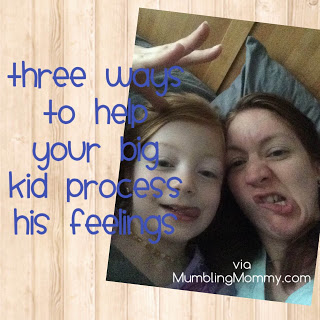Children are people. We forget this as adults sometimes. When we get mad or have a bad day, we do a variety of things to wind down. We drink alcohol. We take hot baths. We exercise. We indulge in fried foods. And some of
us do things even more extreme on both ends of the spectrum. But what about when your child has a bad day? Or worse, has a lot of bad days? How do kids process feelings that they have?
Everyone needs an outlet to express feelings. Eating healthy and staying physically active are good ways to keep those happy hormones pumping, but what about those feelings that your child doesn’t yet know how to express or how to understand? In toddlers, this confusion comes out as crying, kicking, screaming, etc. But in older, school-aged children, many of the tantrum-like expressions have stopped, but the feelings are still there, building. Don’t ignore or minimize your child’s feelings. Empathize with their frustrations and help kids process feelings they are having in one of these ways:
3 Ways to Help Kids Process Feelings
- Color therapy. Pick a sensory item of some sort. Play-Doh, water beads, and shaving cream all work well. Have your child pick one color in relation to how he is feeling. Red could be angry, yellow for excitement, blue for sad, purple for worried, and green for sick or nervous. Allow the child to play with the sensory item in the color that expresses his feeling for 10-15 minutes with no other distractions. This quiet time will busy the body but allow the brain to process. Encourage your child to just squish the sensory item rather than trying to create a final product. It is meant to be relaxing and a little bit boring. When the child is done, clean up the colored item and allow him to play about 5 additional minutes with the same sensory item but in a clear or white color now. This symbolizes that the child has processed the feeling and cleared his mind.
- Draw a brain picture. You can do a quick search online for a silhouette outline, or your child or you can draw one freehand. Once ready, have your child draw a picture of what is inside his brain. The picture
doesn’t have to make sense. Don’t pressure your child to describe the picture. Make sure he knows you are available to talk if he wants to, but respect his space. - Crumple up a story. Have your child write a story about how he feels or what happened to upset him. When he is finished, have him crumple up the piece of paper. He can stomp on it. He can tear it up into small pieces. He can throw it in the recycling bin. This allows him to get the story out of his head and literally get rid of it. The symbolic act helps children find a way to not dwell on bad times.
It is important to allow your child to feel sad. Do not make her feel bad about not being happy. These tools are ways to help children get stuck feelings out of their brains, but a lot of love is still needed and if they don’t feel better right away, don’t feel discouraged. Keep working with your child and if the concern feels like too much for you to handle, seek help from the school counselor or a professional who has experience with children.
First time here? Like Mumbling Mommy on Facebook to continue the conversation.
While you are here, you might also enjoy these posts:
Therapeutic Limit Setting: Using Play Therapy at Home
Thursday Three: Why I Stopped Looking for Mom Friends
Category: Family Free TimeTags: emotions









